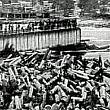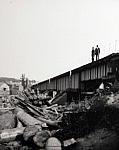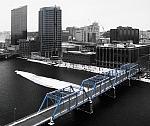Deep Water from Grand Rapids to Lake Michigan
It is an impossibility to move Grand Rapids to Lake Michigan but it is not impossible to bring Lake Michigan to Grand Rapids. To make Grand Rapids a “lake port” would be a small job for the United States engineers. It would cost less than one one-hundredth of the cost of digging the Panama Canal. It has always been the dream of Senator William Alden Smith to see the big lake steamers such as the new “City of Grand Rapids” lying at the docks along the Grand River inside the city limits of Grand Rapids.
On Wednesday, July 16th, the committee of one hundred sojourned to Lake Michigan and while dining at the Ottawa Beach Hotel the question of the “Grand River, twenty feet deep and four hundred feet wide from Grand Rapids to Grand Haven” was presented to the members of the committee by Senator Smith, United States Engineer Joseph C. Sanford and Internal Revenue Collector George Clapperton.
At this meeting it developed, first, that the project must have Colonel Sanford’s sanction and, second, it must have the co-operation of the citizens of Grand Rapids and the city of Grand Rapids. It also developed that if the project was made a reality that Grand Rapids would secure at one and the same time absolute flood protection and deep water connection with all lake ports neither of which we have at the present time. Senator Smith assured Colonel Sanford that he need not fear for the co-operation of the business men of Grand Rapids on any proposition such as the one under discussion when once they were assured that the same was strictly business and highly efficient.
Colonel Sanford assured the members of the committee of one hundred that as far as he was concerned he was heartily in favor of the proposition and also that he had sent out over one hundred letters to the business men of this city asking them for certain information and their opinion of the matter. He also added: “The Government must have definite assurance that the people of Grand Rapids are sincere in saying the proposition would be a good one and the greatest argument they could advance would be to guarantee financial assistance in the work.”
Mr. Clapperton spoke of “twenty feet of water four hundred feet wide” and when advised by Colonel Sanford that nothing over fifteen feet of water would be possible under the law, Mr. Clapperton replied: “Well it isn’t impossible to want it nor to ask for it and then take the most we can get, but let us forget forever six feel of water and flat bottom boats.”
The committee traveled in a special car and after the luncheon and “feast of reason” many of the committee members remained until late in the afternoon in order to enjoy a “dip in the lake” which some day may be possible at the foot of Fulton Street.
Copied from Grand Rapids Progress, July 1913, page 125
Follow up:
Projects for the improvement of Michigan rivers and harbors are nearly completed and the government is not encouraging any new improvements according to the report of the chief engineer of the US Army presented to congress.
The report made no recommendation for a further appropriation for Grand River. The report stated that the total cost to date of the building of a six-foot channel, 100 feet wide from Grand Haven up Grand River to Fulton St. Bridge has been $601,791. A further examination of Grand River with a view to a ten-foot channel project which was asked for by Senator William Alden Smith is declared inadvisable at this time.
Excerpted from the Grand Rapids Press, Dec. 10, 1914, pg 10

 facebook
facebook






